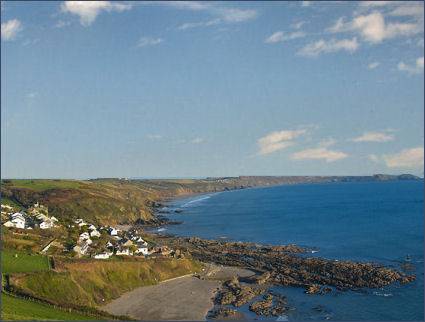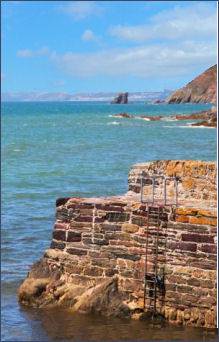Portwrinkle
OS Grid ref:- SX 357 539
 The small coastal village of Portwrinkle in south-east Cornwall, is situated at the western end of scenic Whitsand Bay and lies five miles (8 km) to the south-west of the historic town of Saltash and 18 miles from Plymouth in Devon.
The small coastal village of Portwrinkle in south-east Cornwall, is situated at the western end of scenic Whitsand Bay and lies five miles (8 km) to the south-west of the historic town of Saltash and 18 miles from Plymouth in Devon.
The coastline around Portwrinkle is characterised by high cliffs, dramatic scenery and long stretches of sandy beaches. Portwinkle itself offers fine views along Whitsand Bay. Smuggling was once rife along this coastline and the old coastguard boathouse and cottages which housed the coastguards can still be seen.
Known in the Cornish language as Porthwykkel, Portwrinkle has a history which stretches back to medieval times, it was traditionally a fishing village and the old seventeenth century walls of the pilchard cellars are still standing, although they have been incorporated into housing.
 In the early 1600s the Carew family of Antony granted a lease to Oliver Walleys of Sheviock to build of pilchard storage and processing works. The small harbour was constructed soon after the pilchard processing facilities, the cost was shared by the Carew family and the inhabitants of Sheviock. In the early part of the twentieth century when fishing was no longer a thriving industry, the pilchard cellars became home to soldiers for a short time before they were sent to France to fight in the First World War.
In the early 1600s the Carew family of Antony granted a lease to Oliver Walleys of Sheviock to build of pilchard storage and processing works. The small harbour was constructed soon after the pilchard processing facilities, the cost was shared by the Carew family and the inhabitants of Sheviock. In the early part of the twentieth century when fishing was no longer a thriving industry, the pilchard cellars became home to soldiers for a short time before they were sent to France to fight in the First World War.
The village has a small harbour and two beaches are accessible from it. The two sand and shingle beaches have numerous rock pools, Portwrinkle is a popular location with families and the east beach, known as Finnygook Beach, can be used by experienced surfers. Dogs are not allowed on the beaches between Easter and October.
Although the village has no shops, apart from the beach car park cafe, there is a post office in nearby village of Crafthole. The Finnygook Inn, a fifteenth century inn located close to the South West Coast Path at Crafthole, offers traditional pub lunches.
Eglarooze Cliff, part of Battern Cliffs, near Downderry, is known in Cornish as Eglos Ros and lies to the west of the village, the cliff is designated a Site of Special Scientific Interest for its biological interest. It is noted to contain 2 endangered plant species, the slender bird's-foot trefoil and carrot broomrape.
Sharrow Beach is a sandy beach stretches from Polhawn Cove in the south east, westwards to Finnygook Beach at Portwrinkle, a distance of 7.2kms. Sharrow Grotto was excavated by a an ex naval purser known as Lugger in 1784 in an attempt to ease gout. It has interesting inscribed verses carved into the stone. The cave is owned by the National Trust and is fenced off to the public.